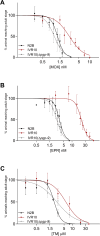P-glycoprotein-9-mediated multidrug tolerance in Caenorhabditis elegans
- PMID: 41168850
- PMCID: PMC12573861
- DOI: 10.1186/s13071-025-07091-5
P-glycoprotein-9-mediated multidrug tolerance in Caenorhabditis elegans
Abstract
Background: The active drug efflux pumps P-glycoproteins (PGPs) are the cornerstones of multidrug resistance in many organisms. In parasitic helminths, resistance to macrocyclic lactones (MLs) has been associated with pgp regulation and structural defects in amphids. In Caenorhabditis elegans, the nuclear hormone receptor (NHR)-8 also influences xenobiotic tolerance by regulating pgp genes. However, the specific contribution of individual transporters and their regulation remain poorly defined. We recently demonstrated that PGP-9 specifically contributes to ivermectin (IVM) tolerance in an IVM-resistant C. elegans strain. This study aimed to explore the role of PGP-9 in drug efflux in C. elegans.
Methods: We used the IVM-resistant and dye-filling defective (Dyf) C. elegans strain IVR10 and a pgp-9 IVR10 mutant to assess larval development under MLs (eprinomectin (EPR) and moxidectin (MOX)) and tunicamycin (TM). We evaluated whether the Dyf phenotype was affected by pgp-9 deletion. We investigated the role of NHR-8 in regulating pgp-9 via reverse-transcription quantitative polymerase chain reaction (RT-qPCR) and by assessing ML sensitivity in an IVR10 nhr-8 mutant. Additional candidate regulators of pgp-9 were also tested.
Results: IVR10 displayed resistance to MLs and to TM, while pgp-9 deletion restored full drug sensitivity despite the persistence of the Dyf phenotype. Although nhr-8 deletion in IVR10 increased IVM sensitivity, pgp-9 expression was not significantly altered in that strain or IVR10. Interfering RNA (RNAi) targeting pgp-9 in the nhr-8 mutant further increased IVM sensitivity, uncoupling PGP-9 from NHR-8 regulation. Candidate NHRs did not affect IVM tolerance in N2B.
Conclusions: These results provide the first direct evidence that PGP-9 is necessary for multidrug tolerance in C. elegans, independently of amphid structural defects and NHR-8 regulation. These findings uncover a novel mechanism supporting drug resistance and highlight PGP-9 as a potential therapeutic target to improve ML treatments.
Keywords: Caenorhabditis elegans; Amphids; Anthelmintic; Macrocyclic lactones; NHR-8; Nuclear hormone receptor; P-glycoproteins; PGP-9; Resistance.
© 2025. The Author(s).
Conflict of interest statement
Declarations. Ethics approval and consent to participate: Not applicable. Consent for publication: Not applicable. Competing interests: The authors declare no competing interests.
Figures




References
-
- Engle K, Kumar G. Cancer multidrug-resistance reversal by ABCB1 inhibition: a recent update. Eur J Med Chem. 2022;239:114542. - PubMed
-
- Dong J, Yuan L, Hu C, Cheng X, Qin J-J. Strategies to overcome cancer multidrug resistance (MDR) through targeting P-glycoprotein (ABCB1): an updated review. Pharmacol Ther. 2023;249:108488. - PubMed
-
- Lespine A, Blancfuney C, Prichard R, Alberich M. P-glycoproteins in anthelmintic safety, efficacy, and resistance: (trends in parasitology 40, 896–913; 2024). Trends Parasitol. 2025;41:334. - PubMed
MeSH terms
Substances
Grants and funding
LinkOut - more resources
Full Text Sources
Miscellaneous

